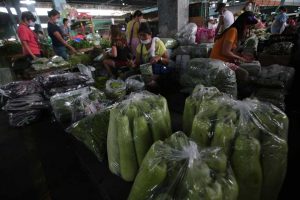Wholesale price growth in the country and retail price growth in the National Capital Region (NCR) both eased to multiyear lows in May amid base effects, the Philippine Statistics Authority (PSA) reported on Friday.
Preliminary data from the PSA showed the country’s general wholesale price index (GWPI) inched up by 2.3% year on year that month, significantly lower than the 5% a year earlier and the 2.6% in April.
May’s reading was the slowest in almost three years or since the 2.2% recorded in June 2021.
Year to date, GWPI averaged 2.8%, lower than the 5.5% a year ago.
Meanwhile, in a separate release, the general retail price index (GRPI) in Metro Manila eased to 2%, lower than the 4.9% a year earlier and 2.1% in April.
The current level was the slowest in more than two years or since the 1.9% growth in January 2022.
In the five months to May, GRPI increased by an average of 2.1%, cooling down from 5.8% logged a year earlier.
“This year-on-year decrease likely reflects a high inflation base from 2023, potentially lower global commodity prices, and improving supply chain,” Robert Dan J. Roces, chief economist at Security Bank Corp. said in a Viber message.
The PSA attributed the downtrend of the GWPI in miscellaneous manufactured articles, which slowed to 0.3% year on year in May from 2% in April.
This was followed by beverages and tobacco (3.1% in May from 4.4% in April), crude materials inedible except fuels (4.2% from 8.4%) and chemicals including animal and vegetable oils and fats (2% from 2.3%).
Other commodities that logged slower growth were manufactured goods classified chiefly by materials (1.1% from 1.6%) and machinery and transport equipment (0.4% from 0.5%).
Bulk prices growth in the three major island groups ended mixed in May.
Wholesale price growth in Luzon went up by 2.2%, easing from 2.4% in April and 4.9% in May last year.
In the Visayas, GWPI likewise slowed to 5.6% in May, significantly lower from 6.7% in April and 3.9% in May 2023.
On the other hand, price growth in Mindanao grew by 1.9% against 1.1% in April but still lower than the 5.7% a year earlier.
Meanwhile, the slowdown in GRPI in Metro Manila was primarily caused by the heavily weighted food index at 2.5% during the period from 2.6% in April, the PSA said.
The same following commodity groups dragged the retail price growth in NCR: beverages and tobacco (3% from 3.7%), crude materials inedible except fuels (0.6% from 0.8%), chemicals, including animal and vegetable oils and fats (2.2% from 2.5%) and manufactured goods classified chiefly by materials (1.3% from 1.4%).
Mr. Roces said that the slowdown is expected to persist in June with year year-on-year growth rates potentially even lower than the reported figures.
“Predicting the full year’s trend requires further data, but the current data suggests a significantly cooler pricing environment compared to 2023,” Mr. Roces said. — Abigail Marie P. Yraola
